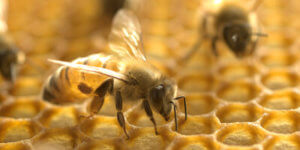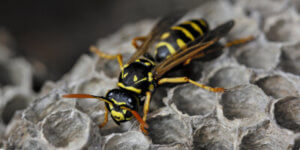Knowing how to identify the insect you’re dealing with can help you treat a sting or help with the extermination process. Here are 4 main differences between bees and wasps.
Spend some time outdoors in the spring and summer and you’ll likely encounter the buzzing of a bee or wasp. If you’re unlucky enough to be stung, you might wonder what you crossed paths with, especially if you have an allergy or you fear there’s a nest near your home.
Both insects are part of the Hymenoptera order and Apocrita suborder of insects, so they have a lot in common. In fact, scientists believe that modern bees evolved from wasps more than 130 million years ago.

Despite the commonalities, there are also plenty of differences. Knowing how to identify the insect you’re dealing with can help you treat a sting or help with the extermination process. These are four of the main differences between bees and wasps.
Stingers
Both insects can deliver a painful sting to anyone or anything they deem a threat, especially when protecting their nest. How it responds after stinging you can indicate whether it’s a bee or wasp.
Bees can only sting once. This is because their stingers are barbed, so they remain in your skin after the bee stings and flies away. Once the stinger is removed, the bee dies. Wasps, on the other hand, have no barbs on their stinger, so they can sting multiple times – and will if provoked or their nest is threatened.
Body Shape and Size
Thankfully, there are easier ways to distinguish bees from wasps that don’t involve being stung. If you’re

able to get a closer look, the insect’s body shape, color and size can be a dead giveaway. These are some of the main differentiators:
Bees:
- Plump, hairy thorax
- Bullet-shaped
- Black or brown with yellow or orange striations
- Flat, hairy legs not visible during flight
Wasps:
- Slender body with a narrow waist
- Bright yellow and orange color patterns
- Smooth and shiny
- Long back legs that dangle during flight
Nesting Habits
Social bee species, like honeybees and bumblebees, build their hives using a waxy secretion from their abdomens. Hives are comprised of stacked hexagonal cell structures capable of holding a few hundred to tens of thousands of bees, depending on the species. Beehives are commonly found in tree hollows, holes in walls or in the ground.
Wasp nests are also comprised of rounded cells in a single comb or multiple combs stacked on top of each other. Instead of wax, they’re made from a mix of harvested wood fibers and saliva from the queen. This pulpy substance is used to cover the outer surface, giving the nest a smooth, football-like shape and appearance. Some single-comb nests have an umbrella-like shape with exposed cells.
These are some of the places wasps will commonly hang their nests:
- Underneath flat surfaces, like decks or porch ceilings
- Underneath roof awnings and eaves
- Door and window frames
- On high tree branches
Feeding Habits
Another difference between the two is what they eat. Bees are pollinators – they visit various plants to collect and distribute pollen. They also feed on flower nectar and pollen during this process, while occasionally visiting trash cans to find sweet nectar-like remnants.
Conversely, wasps are carnivorous predators. They prey on flies, caterpillars and other arthropods, mostly feeding them to their young. Many adult wasps are also attracted to sweet drinks, like juice and soda. Yellowjackets, for example, can subsist on sugary juices entirely.
It’s worth noting that their body types are key in their feeding habits – wasps have a more slender, sleek body to help with hunting, while bees’ hairy, robust thoraxes aid in pollen collection.
Do You Have a Bee or Wasp Problem?
Recognizing the type of pest you’re dealing with is the first step in removal. If you suspect a bee or wasp nest has been built near your home, don’t wait to contact an experienced pest control professional. The pest control experts at OPC Services have more than 40 years of experience providing pest control services to the Louisville, Frankfort, and Southern Indiana areas. Contact us online today to schedule an